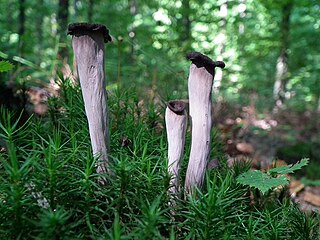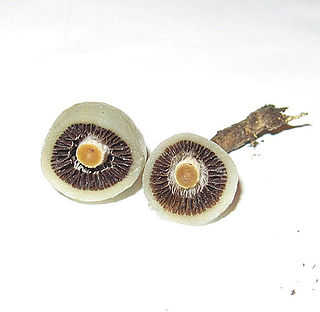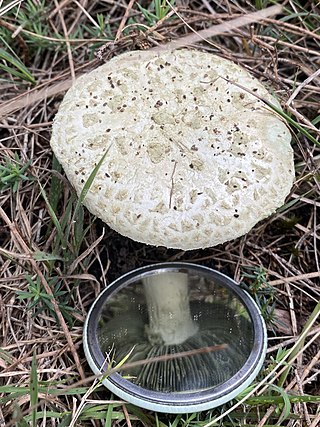
The International Plant Names Index (IPNI) describes itself as "a database of the names and associated basic bibliographical details of seed plants, ferns and lycophytes." Coverage of plant names is best at the rank of species and genus. It includes basic bibliographical details associated with the names. Its goals include eliminating the need for repeated reference to primary sources for basic bibliographic information about plant names.

Craterellus is a genus of generally edible fungi similar to the closely related chanterelles, with some new species recently moved from the latter to the former. Both groups lack true gills on the underside of their caps, though they often have gill-like wrinkles and ridges.
Index Fungorum is an international project to index all formal names in the fungus kingdom. As of 2015, the project is based at the Royal Botanic Gardens, Kew, one of three partners along with Landcare Research and the Institute of Microbiology, Chinese Academy of Sciences.
Johann Friedrich Klotzsch was a German pharmacist and botanist.

Pier Andrea Saccardo was an Italian botanist and mycologist. His multi-volume Sylloge Fungorum was one of the first attempts to produce a comprehensive list of identified fungi, using their spore-bearing structures for classification. He was elected to the Linnean Society in 1916 as a foreign member. He also authored a color classification system that he called Chromotaxia and contributed to the Italian translation of Charles Darwin's Insectivorous Plants.
MycoBank is an online database, documenting new mycological names and combinations, eventually combined with descriptions and illustrations. It is run by the Westerdijk Fungal Biodiversity Institute in Utrecht.

Karl Wilhelm Gottlieb Leopold Fuckel was a German botanist who worked largely on fungi.

Coryneopsis rubi is a plant pathogen.
Elsinoe rosarum, Anthracnose, is a fungal plant pathogen. It is a condition found on roses, causing leaves to have irregular dark margins and spots. The disease usually appears during wet weather.

Gymnopilus purpuratus is a species of agaric fungus in the family Hymenogastraceae. It grows in clusters on dead wood, tree stumps and wood chip mulch. It is widely distributed and has been recorded in Argentina, Australia, Chile, New Zealand, the UK and Germany. It has a broadly convex cap covered in small dry reddish-brown scales, a stout yellow stem beneath reddish brown, wine-red to purple vertical fibres, and a thick rusty orange spore print.

Weraroa was a genus of mushrooms from the families Hymenogastraceae and Strophariaceae. The genus was initially described by mycologist Rolf Singer in 1958 to accommodate the single species Secotium novae-zelandiae reported by Gordon Herriott Cunningham in 1924. It was thought that the genus represented an intermediary evolutionary stage between a hypogeous (underground) ancestor and the related epigeous genus Stropharia. Advances in phylogenetics and taxonomic changes since 1958 found it contained unrelated species from multiple genera. It is now considered a synonym of the genus Psilocybe.

The Ganodermataceae are a family of fungi in the order Polyporales. As of April 2018, Index Fungorum accepts 8 genera and 300 species in the family. The family was circumscribed by Dutch mycologist Marinus Anton Donk in 1948 to contain polypores with a double spore wall. The inner wall is verruculose to ornamented, thickened and usually coloured, while the outer wall is thin and hyaline.

Leucoagaricus is a genus of mushroom-forming fungi in the family Agaricaceae. As of March 2023 there are over 200 accepted species of Leucoagaricus with ongoing research into the genus adding several more each year. Leucocoprinus is a similar genus and considered by some sources to be indistinct from Leucoagaricus based on genetic data that demonstrates they are monophyletic. Species are separated into these genera based on macroscopic features such as cap striations in Leucocoprinus or the more persistent basidiocarps (mushrooms) of Leucoagaricus as well as microscopic features such as the lack of a germ pore in Leucoagaricus species. As a result of the similarities and disagreement on taxonomy, many of the species within these genera have formerly been classified in the other and may still be known by previous classifications. For instance the species Leucoagaricus gongylophorus is cultivated by fungus-growing ants but was formerly known as Leucocoprinus gongylophorus whilst other species cultivated by the lesser attine ants are still classified as undescribed Leucocoprinus species.

František Kotlaba was a Czech botanist and mycologist.

Carlo Luigi Spegazzini, in Spanish Carlos Luis Spegazzini, was an Italian-born Argentinian botanist and mycologist.

Morchella pragensis, commonly known as the Prague morel, is a species of ascomycete fungus in the family Morchellaceae. Found in Europe, it was described as new to science in 1952 by Czech mycologist František Smotlacha.

Amanita austroviridis, commonly known as the Australian verdigris lepidella, is a species of agaric fungus in the family Amanitaceae native to Australia.

Amanita armeniaca is a species of agaric fungus in the family Amanitaceae native to Australia.
Hygrophoropsis mangenotii is an edible gilled mushroom of the genus Hygrophoropsis native to the Ivory Coast. It was described in 1954 by Marcel Locquin.














